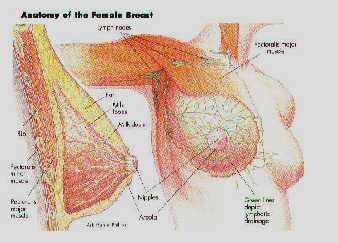|
A women's breasts change throughout her life. Factors such age, monthly menstrual cycle, pregnancy, breast feeding, birth control, menopause, or a bruise or blow to the breast can cause these changes.
Because most breast lumps are found by women themselves, you should learn how to examine your breasts and do so monthly. Besides, doing it yourself (and having your husband assist) reduces stress and time and costs of having it done elsewhere or at an exam center. However, nothing takes the place of a professional, so if you find something suspicious, then you need to immediately get to your medical provider for an in-depth examination.
As you examine yourself you will develop more confidence in knowing how your breasts normally feel and thus you should be able to recognize any changes that may occur. If you do find a change, don't let fear keep you from seeing your medical provider as most breast lumps are benign. If breast cancer is found and treated early, a woman has more treatment options and a good chance of complete recovery, so early detection is important. Self-examination should be one component of your breast health program, which also should include a mammography at an appropriate age and physical examination of your breasts by a trained medical professional.
Breasts are made up of ducts, lobes, lobules, fibrous tissue, and fat, with underlying muscle and bone (ribs). Therefore it is normal for breasts to feel lumpy or uneven.
Step 1: Begin by looking at your breasts in the mirror with your shoulders straight and your arms on your hips.
Here is what you should look for:
- Breasts that are their usual size, shape, and color.
- Breasts that are evenly shaped without visible distortion or swelling.
If you see any of the following changes, bring them to your doctor's attention:
- dimpling, puckering, or bulging of the skin.
- a nipple that has changed position or an inverted nipple (pushed inward instead of sticking out).
- redness, soreness, rash, or swelling.
Step 2: Now, raise your arms and look for the same changes.
Step 3: While you're at the mirror, gently squeeze each nipple between your finger and thumb and check for nipple discharge (this could be a milky or yellow fluid or blood).
Step 4: Next, feel your breasts while lying down, using your right hand to feel your left breast and then your left hand to feel your right breast. Use a firm, smooth touch with the first few fingers of your hand, keeping the fingers flat and together.
Cover the entire breast from top to bottom, side to side and from your collarbone to the top of your abdomen, and from your armpit to your cleavage.
Follow a pattern to be sure that you cover the whole breast.
You can begin at the nipple, moving in larger and larger circles until you reach the outer edge of the breast. You can also move your fingers up and down vertically, in rows, as if you were mowing a lawn.
Be sure to feel all the breast tissue: just beneath your skin with a soft touch and down deeper with a firmer touch.
Begin examining each area with a very soft touch, and then increase pressure so that you can feel the deeper tissue, down to your ribcage.
Step 5: Finally, feel your breasts while you are standing or sitting. Many women find that the easiest way to feel their breasts is when their skin is wet and slippery, so they like to do this step in the shower. Cover your entire breast, using the same hand movements described in Step 4.
It is very important to establish a baseline of awareness in order to determine any changes or variations. So repeat this examination process on a monthly basis. Some women find it easier to take notes in a journal to help track patterns and note any variations .
Remember that breasts may be more sensitive or tender or change shape at certain times during fluctuations in monthly hormone cycles.
Remember that most breast cysts, fibroids or lumps are benign (non-cancerous) so do not panic if you find a lump. Be sure to keep your health care practitioner up to date with any changes.
Diet and excercise and eating habits can play an important part in breast cancer prevention. Start a health and wellness plan today!
|

















